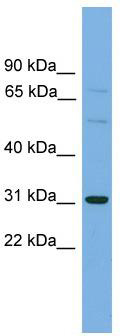OATP2 (SLCO1B1) Rabbit Polyclonal Antibody
Other products for "SLCO1B1"
Specifications
| Product Data | |
| Applications | WB |
| Recommended Dilution | WB |
| Reactivities | Human |
| Host | Rabbit |
| Isotype | IgG |
| Clonality | Polyclonal |
| Immunogen | The immunogen for Anti-SLCO1B1 Antibody: synthetic peptide directed towards the middle region of human SLCO1B1. Synthetic peptide located within the following region: IILIYAMKKKYQEKDINASENGSVMDEANLESLNKNKHFVPSAGADSETH |
| Formulation | Liquid. Purified antibody supplied in 1x PBS buffer with 0.09% (w/v) sodium azide and 2% sucrose. Note that this product is shipped as lyophilized powder to China customers. |
| Purification | Affinity Purified |
| Conjugation | Unconjugated |
| Storage | Store at -20°C as received. |
| Stability | Stable for 12 months from date of receipt. |
| Predicted Protein Size | 76 kDa |
| Gene Name | solute carrier organic anion transporter family member 1B1 |
| Database Link | |
| Background | This gene encodes a liver-specific member of the organic anion transporter family. The encoded protein is a transmembrane receptor that mediates the sodium-independent uptake of numerous endogenous compounds including bilirubin, 17-beta-glucuronosyl estradiol and leukotriene C4. This protein is also involved in the removal of drug compounds such as statins, bromosulfophthalein and rifampin from the blood into the hepatocytes. Polymorphisms in the gene encoding this protein are associated with impaired transporter function. |
| Synonyms | HBLRR; LST-1; LST1; OATP-C; OATP1B1; OATP2; OATPC; SLC21A6 |
| Note | Immunogen sequence homology: Human: 100%; Bovine: 86%; Pig: 79% |
| Reference Data | |
| Protein Families | Druggable Genome, Transmembrane |
Documents
| Product Manuals |
| FAQs |
{0} Product Review(s)
0 Product Review(s)
Submit review
Be the first one to submit a review
Product Citations
*Delivery time may vary from web posted schedule. Occasional delays may occur due to unforeseen
complexities in the preparation of your product. International customers may expect an additional 1-2 weeks
in shipping.






























































































































































































































































 Germany
Germany
 Japan
Japan
 United Kingdom
United Kingdom
 China
China



